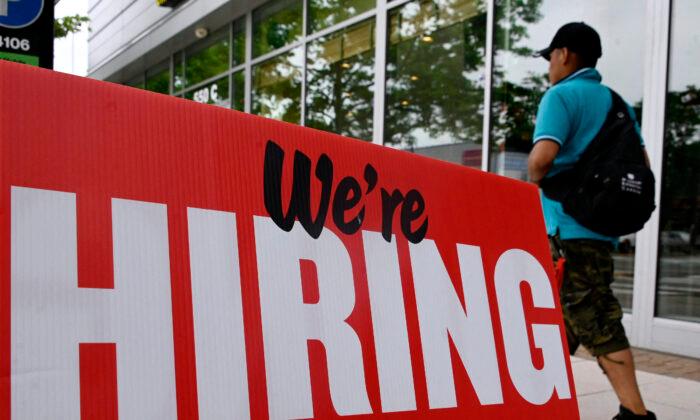The U.S. economy added 263,000 new nonfarm jobs in November as wages jumped amid solid employment gains in industries that were hardest hit by the pandemic, according to the Bureau of Labor Statistics (BLS) on Dec. 2. While the number is down from 284,000 in October, analysts had forecast an increase of 200,000 jobs.
The unemployment rate held at 3.7 percent.
The September jobs report was revised down by 46,000 to 269,000, and the change for October was revised up by 23,000.
Average hourly earnings rose 5.1 percent year-over-year and edged up 0.6 percent from October to November to $32.82. Average weekly hours slipped to 34.4, from 34.5. The labor force participation rate also dipped to 52.1 percent from 62.2 percent.
Leisure and hospitality led the way with 88,000 new jobs, followed by health care (45,000) and government (42,000). Construction employment rose by 20,000, information climbed by 19,000, and financial activities jumped by 14,000.
Employment in the retail trade fell by 30,000, while transportation and warehousing also lost 15,000 positions. There was little change in professional and business services, mining, and wholesale trade.
Leading Up to November Jobs Report
Experts believe that the red-hot labor market could be showing signs of cooling down.“The data suggest that Fed tightening is having an impact on job creation and pay gains. In addition, companies are no longer in hyper-replacement mode. Fewer people are quitting and the post-pandemic recovery is stabilizing,” ADP Chief Economist Nela Richardson said in the report.
Tech Sector Hit
“The tech sector has announced the most job cuts this year by far. While other industries are cutting jobs at a slower pace, hiring appears to have slowed as well,” Andrew Challenger, senior vice president of Challenger, Gray & Christmas Inc., said in a statement.Despite the increasing number of tech layoffs this year, John Leer, the chief economist at Morning Consult, believes that labor conditions remain resilient.
Still, could 2023 be when the U.S. labor market significantly weakens? The base case for many market analysts is a recession or, at the very least, a slowdown.
“The economy will slow into 2023—whether we actually get a recession or not (the yield curve says YES!) we are slowing,” Laffer Tengler Investments CEO and Chief Investment Officer Nancy Tengler said in a note.
As a result, the unemployment rate could rise to about 5 percent by the end of next year, according to Jill Gonzalez, a WalletHub analyst.
For Goldman Sachs, the growing number of layoffs in the tech sector may not be a signal for a recession, adding that it might not be a leading indicator of a deterioration in the broader labor market.
“Tech layoffs are therefore an unfortunate side effect of the growth slowdown and tighter financial conditions necessary to rebalance the broader labor market, but for now appear narrowly concentrated and are probably not indicative of labor market dynamics in other sectors.
Next Steps for Federal Reserve
“This shouldn’t be surprising news, since the Fed is taking further steps to damper inflation,” Gonzalez said in a report by the personal finance website. “While higher unemployment is bad for the families affected, it is good news for the economy as a whole in the current inflationary environment because it should eventually lead to a decrease in inflation. The current projections should also lead to a decrease in interest rates in 2024, once inflation has hopefully subsided enough.”According to Jan Szilagyi, CEO of the investment research firm Toggle AI, the better-than-expected jobs report should encourage the Fed to frontload its rate increases.
“Public and market tolerance for tighter monetary policy is far higher with the unemployment rate below 4%, a historic low,” he wrote in a note. “When it eventually rises above 5%, the Fed will face more pressure to take into account the tradeoffs between employment and inflation. They have a brief window to act aggressively, and they seem eager to use it.”
That said, Szilagyi believes that the central bank could employ its first rate cut in late 2023 or the first quarter of 2024.
Gonzalez believes unemployment should start to rise at a notable pace following the December meeting.





